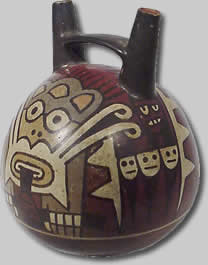Nazca Lines Culture

The Nazca culture flourished in the Nazca region between 300 BC and 800 AD and are known for the impressive Nazca lines they created in the Nazca desert region. However the Nazca culture also showed great technological advancies having created aquaducts and many ceramic and textile artifacts that have been discovered.
Pottery was an important part in the make up of Nazca life and was also renowned for its technological refinement with advanced patterns, motifs and symbolism. The pottery of Nazca has been divided into three stages being early, classic and later stages of creation. The first stage of pottery involved little colour however as their skills developed more complex designs and colours appeared towards the classic and later stages of Nazca pottery.

Traditional patterns include drawings of animals such as fish and birds although plants, people and what were percieved to be Nazcan religious figures were also common. The colours that tended to be used were black for out lining images with red, white, brown, yellow, gray and violet. Bowls and beakers were common shapes for Nazca pottery, but double-spout and head-and-spout jars are also found. Many of the artifacts have been discovered in and around the valleys of Chincha, Pisco, Ica, Nazca and Acari.
The Nazca culture and lifestyle was also renowned for its textiles as they began using llama and massive quantities of alpaca many years before the north coast cultures began to esteem the camelid wool. The source of the wool is believed to be from the Ayacucho region. The motifs that appeared on the pottery appeared earlier in the textiles. Due to the climate of the desert it has helped to preserve the textiles that the Nazca culture have created which has enabled archeologists to ascertain most of what we know about early textiles in the region.

